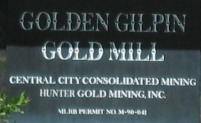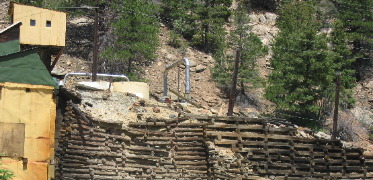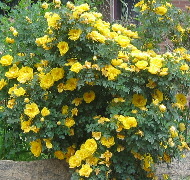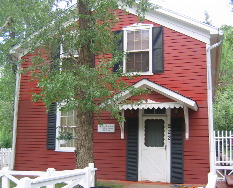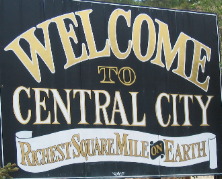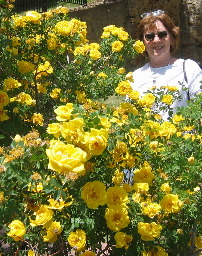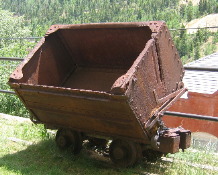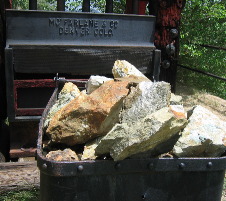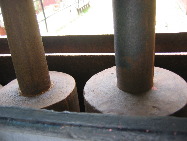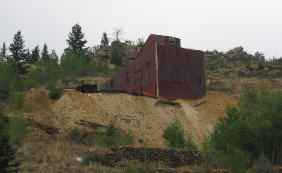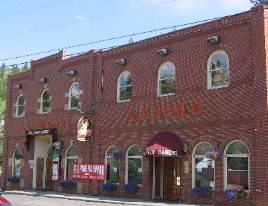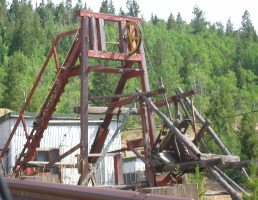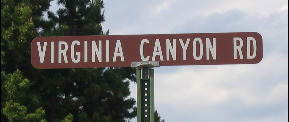Central City, ColoradoJune 27th 2006: Golden, Colorado (just west of Denver). We are in Clear Creek City Park N39° 45.197' W105° 13.193'. The campground is located on the south side of 10th street at the end of the road. Clear Creek City Campground is one of the nicest (location wise) campgrounds you can stay in (our opinion). located on Clear Creek 3-blocks from downtown Golden. They have paved interior roads with small backin sites (mature trees are so wonderful); 50-amps, water and sewer, $28.91 per-night 303-278-1437. There is a 2-week max stay before you have to leave the park and they do not take reservations. Central City & Black HawkJoyce planned for us to visit Central City and Black Hawk today. These are two famous Gold Rush towns. The two towns are situated barely one mile apart 8,000' up in the Rocky Mountains front range only 20-miles from the foothills back in Denver and Golden. These two small gold mining towns were important before Colorado became a territory. In fact they are the main reason Colorado became a territory in 1862 (because of all the gold) and within 15-years after becoming a Territory Colorado became a state. But I am getting ahead of myself. White folks (Europeans) had only ventured into the Rocky Mountains for short periods of time and only for exploration purposes prior to that day in early May 1859 when John Gregory discovered the "source" for the gold he and others were finding in Clear Creek around present day Denver. History tells us that Coronado the great Spanish explorer led an expedition through some of Colorado in 1540. A major part of Colorado became US property as the result of the Louisiana Purchase in 1802. Note that 1802 is 262 years since Europeans first set foot in Colorado. Louis and Clark explored and found a route to the Pacific Ocean in 1804 (note that Louis & Clark did not enter Colorado). Pike led an early expedition in 1806 that wandered along the front range of the Rockies. Then in 1843 General William Fremont reconnoitered the front range of the Rockies. The other white men that ventured into this wild unknown land were the Mountain Men who were generally married to Indian women and wandered up streams and creeks in search of beaver. A group of men traveling from Georgia panned for and found gold in Clear Creek around present day Denver. One man "John Gregory" possessed enough geological knowledge to know that gold in Clear Creek had to come from a source that more than likely would contain much more gold than could be found in the creek. He began to work his way up Clear Creek panning for gold along the way. As Gregory suspected he followed the gold in Clear creek to the source. When he arrived at Central City/Black Hawk he found the mother rock/outcropping where the gold in Clear Creek was coming from. Because Gregory understood a little geology he understood that the vein of gold bearing oar should be on both sides of Clear Creek and wisely made claims on both sides thus securing one of the largest gold sources ever. However, there is always an however, isn't there. The gold bearing rock was hard rock that would require specialized equipment and individuals skilled in hard rock mining. Americans were NOT skilled in hard rock mining. Americans knew how to pan for gold in streams not extract hard rock from the face of a mountain and develop mines that went deep in the mountainside. The industry, such as it was, turned to Europe. Cornish miners were skilled at mining tin a metal that has to be extracted by hard rock mining techniques, like the skills needed here. Irish miners were skilled in extracting coal. Within the year experienced miners were flooding into the Central City/Black Hawk area to work the mines. Thousands of men flocked to the area in the summer of 1859 and within three years 100,000 people made the 600-mile journey across the plains from Independence, Missouri to this area.
Golden Gilpin Gold Mill Central City, Colorado
There was no law here in the beginning. Prior to 1859 the only "Americans" in the area were people who traded with the indigenous Indians and the Mountain Men who hunted and trapped. The only "law" in the area was that of the American Fur Company. Outside the American Fur Company forts/compounds every man was his own lawmaker and his laws were enforced with his gun. With the discovery of gold in 1859 laws were required with the burgeoning population in the mining camps. It was the State of Kansas (Kansas Territory) that had the authority but did not provide any enforcement in the mining camps. Miners got together and formed the Miner's Court sometime in 1859 after the discovery of gold in May. They enacted some laws criminal and civil. The laws were crude as in: "Any person guilty of willful murder, upon conviction thereof, shall be hung by the neck until he is dead." Or: "Any person found guilty of grand larceny shall be fined in a sum double the amount stolen, and receive not less than fifty nor more than three hundred lashes on his bare back, shall be banished from the district, and such other punishment as a jury of six men may direct." It is fairly easy to see that the mining district's intent was to rid the community of riffraff. Citizenship in the mining district was defined as follows: "Any person owning a claim or working or living in this district, shall be entitled to a vote and all the rights of citizenship." Note that EVERYONE regardless of sex or color could vote. In this aspect the Colorado mining district was way ahead of the rest of our "sophisticated" country.
Yellow Roses brought to Central City by Cornish Miners in the 1860's
Cornish miners brought yellow roses to remind them of their homeland. These yellow roses still dot the hillsides around Central City. We are told they are either the original plants or relatives of the ones brought here by the Cornish miners in the 1860's.
Mine Tailings from Mill in Central City
Historic 1870 home in Central City
This home built in 1870 is only one of a number of historic old houses in Central City.
Central City Richest Square Mile on Earth
We couldn't help but be drawn to the welcome sign to Central City proclaiming it the richest square mile on earth. We had to chew on that since other towns claim something similar. Butte, Montana makes a similar claim since it sits on a huge mountain of copper. In Butte they finally dug a giant hole in the ground taking everything out. Cripple Creek 40-miles south of here also produced a mother load of gold and makes a similar claim, I believe.
Yellow Roses brought to Central City by Cornish Miners in the 1860's
Here are those yellow "Cornish" roses again.
Old Oar Cart used in Central City mines & mills
To the right is an old oar cart. Notice how it tips on its side to unload the gold bearing rock. Also note that it is on a very narrow gauge set of tracks only 2-feet apart. While most of the gold was mined in Central City mills to process the oar were located east of Black Hawk a mile or so away and 500 or more feel lower in elevation. Since trains can only handle grades of 6% or less the railroad had to devise a method to achieve the rapid drop in altitude from the mines in Central City to the mills in Black Hawk. A 500-drop in elevation in less than 2-miles was a major problem. To accomplish this feat of engineering required the railroad to build over 4-miles of track to negotiate that two miles. To do that in these steep mountains required several switchbacks that of necessity required tight turns. The smaller the distance separating tracks the tighter the turning radius. The turning radius required was less than even the narrow gauge tracks could provide. Now you know why they utilized the much smaller 2-foot wide tracks.
Central City Museum
We photographed this load of gold bearing rock at the Central City Museum.
Central City Stamp Mill
The Central City Museum also featured a stamping mill. Stamping mills were used to crush the rocks into powder thus releasing the gold from the parent rock. To the right you can see the cam system that was used to lift and drop the 2,000 pound "stamps" that crushed the oar. One can only imagine the decibel level emanating from these mills as hundreds of stamps crushed oar 24-hours a day 7 days a week.
2,000-pound stamps used to crush the gold bearing rock
This is two of the 2,000-pound stamps used to crush the gold bearing rock.
Original mine at Black Hawk near Central City
This picture is the original source load that Gregory located and claimed. A tin building still covers the entrance to that mine. This is where it all started.
Red Dolly Casino Black Hawk Colorado
The Red Dolly Casino is across the street from Gregory's original mine. Stand in the front door and look across the street and up the hill and you will see Gregory's mine.
Equipment to haul ore out of mine
To the right is the equipment that hauled ore out of one mine in long narrow buckets. Why the narrow bucket you might ask? Money lies in removing oar containing gold, everything else is unproductive work thus only minimal "other-rock" was removed from a mine.
Oh My-God-Road also known as Virginia Canyon Road
After tiring of the museum we headed out on our last and most exciting adventure of the day. The Oh-My-God Road also known as Virginia Canyon Road/RD 279 connects Central City with Idaho Springs 8-miles away and over 2,000' lower in elevation. Oh-My-God Road is partially paved, partially hard packed earth and makes the vast majority of that descent in around 5-miles, thus that part is a serious series of switchbacks designed to literally fall off the south side of the mountain containing all that gold. I'm told it got its name from the reaction of stagecoach passengers riding over it! I think you'll find it less scary today, but still worth the drive. Oh-My-God road at one time was the link between Idaho Springs and Central City. It was a critical access and supply road for miners bringing supplies to there camp by horse and wagon before 1865. Once the railway reached Central City/Black Hawk traffic along the road dwindled. If you are interested in the exciting ride down Oh-My-God Road it is covered in our Oh-My-God Road Travel Adventure here: What a day. It can't get any better. Click here for more EXCITING DRIVES like the Oh-My-God Road Here are some other Travel Adventures in this area that may interest you: Golden, Colorado -- Kayaking Clear Creek in Golden, Colorado -- Golden Farmer's Market -- Hang Gliding on Lookout Mountain -- Buffalo Bill's Grave on Lookout Mountain -- Nature Center on Lookout Mountain Evergreen, Colorado and Bear Creek scenic drive -- Dinosaur Ridge near Morrison, Colorado Central City & Black Hawk, Colorado -- Mountain Goats of Mount Evans -- Clear Creek Canyon Scenic Drive The Oh-My-God Road from Central City to Idaho Springs -- Boulder Canyon Scenic Drive -- Golden, Colorado Evergreen, Colorado -- Kayaking fun in Clear Creek Golden, Colorado -- Mount Evans Scenic Drive -- Lookout Mountain Click here for some Colorado travellogsUntil next time remember how good life is. More Colorado AdventuresAdventures by State ** More 2006 Travel Adventures
Mike & Joyce Hendrix
Mike & Joyce Hendrix who we are We hope you liked this page. If you do you might be interested in some of our other Travel Adventures: Mike & Joyce Hendrix's home page Travel Adventures by Year ** Travel Adventures by State ** Plants ** Marine-Boats ** Geology ** Exciting Drives ** Cute Signs ** RV Subjects ** Miscellaneous Subjects
We would love to hear from you......just put "info" in the place of "FAKE" in this address: FAKE@travellogs.us Until next time remember how good life is.
|
| ||
|
| |||
|
| |||
|
|
